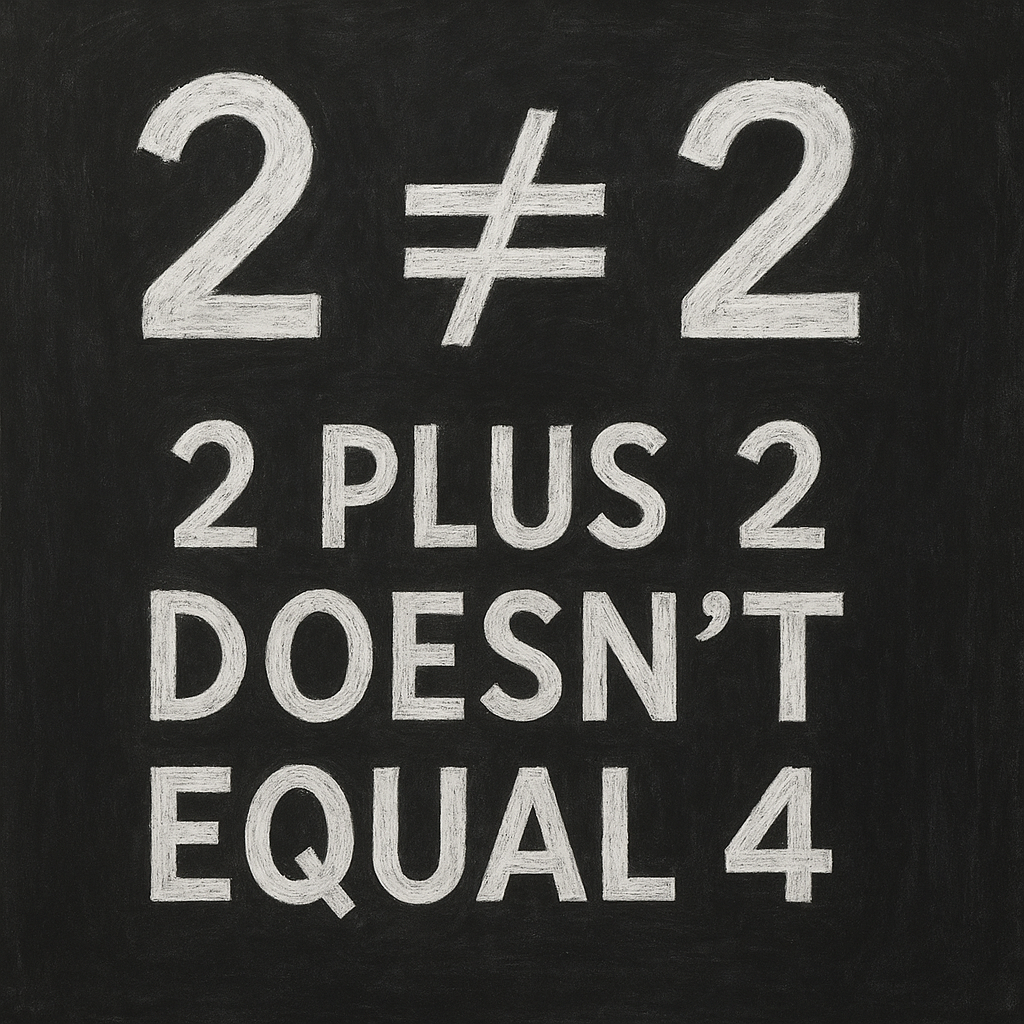
The Flawed Practical Application of Mathematics Due to the Axiom of Equivalence
By Brian French
Mathematics, often heralded as the language of the universe, provides a framework for understanding patterns, quantifying relationships, and solving complex problems. Central to its structure is the axiom of equivalence, which posits that two entities can be considered identical if they share certain properties or satisfy specific criteria. This axiom underpins concepts like equality, congruence, and equivalence relations, enabling mathematicians to compare and manipulate objects systematically.
However, in practical applications, this assumption of equivalence can introduce significant flaws, particularly when applied to the real world, where no two objects are truly identical. If, as the adage goes, no two snowflakes are ever the same, how can we assume equivalence for any objects or phenomena? This article explores the limitations of the axiom of equivalence in mathematical applications, arguing that the inherent uniqueness of objects challenges the validity of equating them in practical contexts.
The Axiom of Equivalence in Mathematics
In mathematics, the axiom of equivalence is foundational. It manifests in the concept of equality (e.g.,
a = b) and in equivalence relations, which must satisfy three properties: reflexivity (
a \sim a), symmetry (if
a \sim b, then
b \sim a), and transitivity (if
a \sim b and
b \sim c, then
a \sim c). These properties allow mathematicians to group objects into equivalence classes, treating members of the same class as “the same” for specific purposes. For example, in modular arithmetic, numbers like 7 and 12 are equivalent modulo 5 because they leave the same remainder when divided by 5. Similarly, in geometry, congruent triangles are considered equivalent under transformations like rotation or translation.
This abstraction is powerful, enabling simplification and generalization. In theoretical mathematics, where idealized objects like points, lines, or numbers exist, equivalence is unproblematic. In practical applications, however—such as physics, engineering, economics, or social sciences—the axiom’s assumption of equivalence often overlooks the unique, irreducible to a common measure that all objects possess in the real world.
The Snowflake: A Metaphor for Uniqueness
The popular saying that “no two snowflakes are the same” serves as a compelling metaphor for the uniqueness of natural objects. Each snowflake, when examined closely, has a distinct microstructure shaped by its unique journey through the atmosphere, with variations in temperature, humidity, and air currents contributing to its form. While snowflakes may appear similar at a macroscopic level, their microscopic differences are undeniable. This observation raises a profound question: if even seemingly simple objects like snowflakes are never truly identical, how can we assume equivalence for more complex entities, such as physical objects, human behaviors, or economic systems?
In mathematics, equivalence often relies on selecting specific properties to compare while ignoring others. For instance, two cars may be considered “equivalent” in a model if they have the same mass and velocity, but this ignores differences in shape, material, or wear and tear, which may be critical in real-world scenarios. The axiom of equivalence, by reducing objects to a set of shared characteristics, risks oversimplifying reality, leading to flawed practical applications.
The Problem of Equivalence in Practical Applications
The assumption of equivalence manifests in various fields, often with unintended consequences. Below are examples illustrating how this flaw undermines the practical utility of mathematical models:
- Physics and Engineering: In classical mechanics, objects are often treated as equivalent based on properties like mass or charge. For instance, Newton’s laws assume that two objects with the same mass respond identically to the same force. However, real-world objects differ in ways that idealized models ignore. Two steel beams may have the same mass and dimensions but differ in microscopic imperfections or manufacturing tolerances, leading to different responses under stress. The collapse of structures like the Tacoma Narrows Bridge in 1940 highlights how neglecting subtle differences can lead to catastrophic failures.
- Economics and Statistics: Economic models often assume equivalence among individuals or entities, such as “rational agents” with identical preferences or firms with similar production functions. In reality, no two consumers or businesses are identical, as preferences, histories, and contexts vary. Statistical methods like regression analysis treat data points as equivalent within a sample, but this can obscure unique factors affecting individual outcomes. For example, assuming two patients respond equivalently to a drug ignores genetic or environmental differences, potentially leading to ineffective treatments.
- Social Sciences: In sociology or psychology, mathematical models may equate individuals based on demographic variables, such as age or income. However, no two people share identical experiences, cultural backgrounds, or psychological states. Treating them as equivalent risks misrepresenting social dynamics. For instance, polling models that assume voters within a demographic are equivalent often fail to predict election outcomes accurately, as seen in the 2024 U.S. presidential election.
- Machine Learning and AI: In data-driven models, equivalence is implicit in clustering or classification algorithms, which group similar data points. However, assuming equivalence based on selected features can lead to biased or inaccurate predictions. For example, facial recognition systems may treat faces as equivalent based on certain metrics, but differences in lighting, angle, or cultural context can lead to misidentification, with significant ethical implications.
In each case, the axiom of equivalence enables mathematical tractability but sacrifices fidelity to reality. By assuming objects or entities are interchangeable, models may fail to account for critical differences, leading to errors or unintended consequences.
Philosophical Implications: The Uniqueness of Objects
The snowflake metaphor extends to a deeper philosophical question: if no two objects are truly identical, what justifies equating them? In metaphysics, the principle of the identity of indiscernibles, proposed by Leibniz, suggests that two objects are identical only if they share all properties. In practice, no two objects meet this criterion, as even seemingly identical items (e.g., two factory-produced screws) differ at the atomic or historical level. The axiom of equivalence, by focusing on a subset of properties, implicitly acknowledges this but chooses to ignore differences deemed irrelevant. This selective ignorance, while pragmatic, undermines the robustness of mathematical applications.
Consider the implications for objectivity. If no two objects are the same, then no two measurements, observations, or experiments are truly equivalent. In science, replicability assumes that experiments conducted under “equivalent” conditions yield equivalent results, but subtle differences in context or equipment can skew outcomes. This challenges the notion of objective truth, as results depend on the unique circumstances of each instance.
Poor Math Students… Were Right All Along
To address the flaws of the axiom of equivalence, mathematicians and practitioners must adopt a more nuanced approach to modeling reality. Several strategies can mitigate the limitations:
- Incorporate Variability: Models should account for variability and uncertainty, using techniques like probabilistic modeling or sensitivity analysis to capture differences among objects. For example, instead of assuming two beams are equivalent, engineers could model a range of possible material properties.
- Context-Specific Equivalence: Equivalence should be defined relative to the specific context and purpose of the model. In medicine, for instance, patients may be considered equivalent for certain treatments but not others, based on relevant biological markers.
- Embrace Complexity: Advances in computational power enable more complex models that capture unique features. Machine learning, despite its flaws, can identify patterns in large datasets without assuming strict equivalence, offering a path toward more realistic representations.
- Interdisciplinary Validation: Mathematical models should be validated against empirical data and insights from other disciplines, such as sociology or materials science, to ensure they account for real-world differences.
- Philosophical Humility: Practitioners must acknowledge the limitations of equivalence, recognizing that all models are approximations. This humility can guide decision-making, encouraging iterative refinement and adaptation.
The axiom of equivalence is a cornerstone of mathematical reasoning, enabling abstraction and simplification. However, its practical application is flawed when it assumes that objects or phenomena can be treated as identical, due to their intrinsic uniqueness. Just as no two snowflakes are identical, no two cars, people, or stars are truly the same, challenging the validity of equating them in mathematical models. This flaw manifests in fields like physics, economics, and social sciences, where oversimplification can lead to errors or harm.
By acknowledging the uniqueness of objects and adopting more flexible, context-specific approaches, we can improve the robustness of mathematical applications, ensuring they better reflect the rich complexity of reality. The snowflake, in its singular beauty, reminds us that equivalence is a useful fiction—but a fiction nonetheless.


